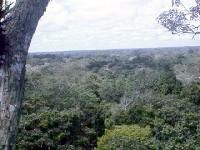
 |
Tropical rain forests are forests of tall, dense trees in regions of warmth and plentiful rainfall. Most tropical rain forests are found near the equator and cover large areas in Africa, Asia, Central and South America, and on Pacific Islands. The largest tropical rain forest is that of the Amazon in South America, also called the selva. The Amazon rain forest covers a third of South America. |
Tropical rain forests stay green all year, and receive a total of 80-160 inches of rainfall a year. There are more species of plants and animals in the tropical rain forests than all of the world's other ecosystems combined. |
 |
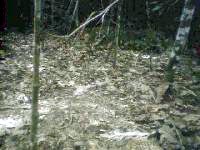 |
Trees in the tropical rain forests make up 70 percent of the plant species and can grow up to 200 feet tall. The crowns, or tops, of these trees form a covering of leaves above the ground called the upper canopy. The crowns of smaller trees form the lower canopy. These canopies shade the forest floor so that it receives very little sunlight (top photo). For this reason, only a few bushes and herbs can grow on the forest floor. Areas where much sunlight reaches the ground and has dense growth are called jungles (bottom photo). Most jungles grow near rivers or former clearings. Thundershowers occur more than 200 days a year, and the air beneath the lower canopy is always humid. The trees in tropical rain forests give off water through the pores of their leaves. This process is called transpiration , which supplies as much as half of the rain in the Amazon rain forest. |
 |
|
People have not dwelt in large numbers throughout the tropical rain forests, but small groups of people live throughout the region. They constantly move around and clear small areas and plant crops. When they reach an area they want to use, they chop down trees and burn them in order to create a clear area. They then plant seeds in the ashes--but after a few years the soil nutrients become used up and it is no longer good for gardening, so they move somewhere else and start the process all over again. This process is called slash-and-burn cultivation, which can support a small population but will not work with larger ones. |
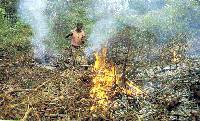 |
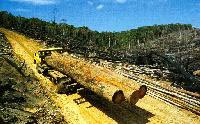 |
Tropical rain forests are now being cleared at an ever-increasing rate worldwide. Scientists estimate that from 13 1/2 million to 55 million acres of tropical rain forests are destroyed every year. Two of the main reasons for cutting down tropical rain forests are because of commercial timber and the needs of an expanding population. All of this massive destruction is leading to the greatest number of plant and animal extinctions the earth has ever experienced. If one animal or plant becomes extinct, most likely it does not effect us, but how many animals or plants can we let become extinct until it does effect us, and we "open our eyes" to this growing problem. |
|
Many people do not know the harm in destroying these tropical rain forests. Trees and plants use the gas carbon dioxide during a process called photosynthesis to make food. However, while it is necessary to have carbon dioxide, having too much can be a problem. Carbon dioxide is a heavy gas that has the property of holding heat and causing the temperature of the surrounding area to rise. Because of the burning and removal of trees and plants in tropical rain forests, the levels of carbon dioxide in the atmosphere are increasing. The amount of carbon dioxide is steadily rising (as are the amount of solid particles that also keep in heat) at about 0.4 percent each year, and the destruction of the tropical rain forests is contributing to the Greenhouse Effect. |
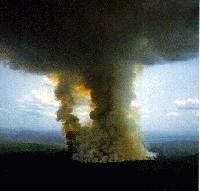 |